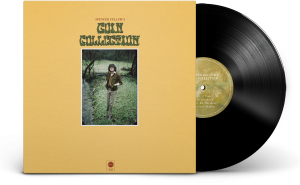Spencer Cullum shares the 1960s-conjuring video to his psychedelic folk song "Jack of Fools."
You might do a double-take at the release date when watching the video for Spencer Cullum’s “Jack of Fools,” which C&I is proud to premiere today. Even just listening to it might give you the same disorienting sense of being taken back to another era, or even to a time and place that never really existed in the first place, some idealized land out of mythology.
The experience gets even trippier when you consider the musician behind the song, which sounds like it could be a forgotten English psychedelic folk record that was unearthed to be given life on a Wes Anderson movie soundtrack, is a Nashville session pedal steel guitarist who’s worked with the likes of Miranda Lambert, Caitlin Rose, Kesha, Little Big Town, and Deer Tick.
 Cullum, a Native Londoner, grew up listening to progressive rock and was first drawn to pedal steel from hearing it on the Rolling Stones’ Exile on Main Street honky-tonker “Torn and Frayed.” Other British rock and pop songs using the instrument drew his attention, and he eventually found someone to teach him pedal steel —and he learned to play the instrument well enough to find himself in demand as Music City session and touring player. Still, though, he wanted to make a record that sounded like it could come from his native country.
Cullum, a Native Londoner, grew up listening to progressive rock and was first drawn to pedal steel from hearing it on the Rolling Stones’ Exile on Main Street honky-tonker “Torn and Frayed.” Other British rock and pop songs using the instrument drew his attention, and he eventually found someone to teach him pedal steel —and he learned to play the instrument well enough to find himself in demand as Music City session and touring player. Still, though, he wanted to make a record that sounded like it could come from his native country.
The resulting solo debut album, Spencer Cullum’s Coin Collection, out November 12th on YK Records, does just that in every detail, including the cover art — even though it’s full of contributions from Nashville session cats. Cullum talked via email to C&I about the album, its opening track “Jack of Fools,” and how its accompanying video manages to look so convincingly like a relic from the ’60s.
Cowboys & Indians: For readers who are not familiar with you and your work, tell us a little about your musical background and history. When did you start playing music and how did you end up playing pedal-steel guitar, an instrument most people associate with country music and might find an unusual choice for a Londoner?
Spencer Cullum: I picked up the pedal steel guitar about 14 years ago from hearing a Rolling Stones song called ‘Torn and Frayed’ that featured Al Perkins on steel guitar. A lot of ’60s and ’70s British rock and pop records that used pedal steel guitar caught my ear. Only to read the liner notes of a Elton John and a Humble Pie record I found out the British pedal steel ‘guy’ back then was BJ Cole. I tracked him down and he taught me how to play pedal steel. We’ve become good friends ever since.
C&I: How did you end up in Nashville and playing with such a variety of acts, like Deer Tick and Miranda Lambert?
Cullum: When I got more comfortable with the steel guitar I would play as much as possible around the London pub circuit, whilst doing that I met a band from Detroit called The Deadstring Brothers and I toured around the U.S. with them.
After I returned to London and got asked to play with Caitlin Rose to tour Europe and the U.S. and just ending up staying in Nashville. It felt like I could have a sense of stability in Nashville from playing steel guitar and picking up session and tour work so just I stayed here.
Even though Nashville is a city it still feels small so everyone knows each other in some sense ... that has its charm and flaws. But it helped me get work with acts like Miranda Lambert, Deer Tick, and others
C&I: You refer to the collaborators on your album as your “coin collection,” an interesting analogy. How did you come to think of them this way?
Cullum: I wanted to make a English-style psych-folk record that featured some of my favorite artists. The idea of a Coin Collection almost has a nod to train spotting or card collecting but a collection of musicians I picked to play together I used to collect soccer (football) coins at school and my dad also had a thing for collecting Royal Family commemorative coins. I don’t think he was much of a royalist ... more of the thought that they’d be worth some money down the line (which they are not, surprisingly).
So it’s my homage to the idea of collecting silly knick-knacks.
C&I: What were you hoping to accomplish with the album and hoping listeners would get out of the album when you first went into the studio, and how do you feel about the results?
Cullum: I’m happy with it....the idea of writing lyrics and singing is new to me. I’ve always been a side musician sitting in the shadows so this felt nerve-wracking and exciting. I’ve always wanted my music to sound naive ... .all my favorite records sound like that, to feel uncomfortable and to feel exposed.
I always like making music that I personally would enjoy. Not to shoot myself in the foot but I went out of my way to not force any commercial aspect to this record...for it to feel subconscious. Whether I’m singing about my dog in my cockney accent or getting the guitar player (Sean Thompson) to do a 1-minute fuzz freak out type solo.
C&I: Many songs on the album, its artwork, and the video for “Jack of Fools” sound and look straight out of the psychedelic 1960s. What is it about this era and sound and aesthetic that appeals to you?
Cullum: Yes, I love that type of music. That was my upbringing and something I feel comfortable and happy playing.
I mostly play country music for work (which I love) but I grew up listening to Pink Floyd, King Crimson, ELP, and prog. However structured that type of music was there was something careless and so expressive about it ... even if they were singing about Mordor and gnomes.
C&I: What is “Jack of Fools” about?
Cullum: "Jack Of Fools” is a composition I wrote with Andrew Combs. It delves into not being able to find an answer when lost or in a dark place emotionally. It stemmed from the idea of using a tarot deck to find answers but forever re-shuffling into a vicious circle, always to draw ‘The Jack of Fools’ (a mix of ‘The Fool’ tarot card and ‘The Jack’ playing card). The recording was a concept I had of a group of Nashville musicians playing their version of Liege & Lief by Fairport Convention, a late-’60s psych-folk record that was one of the inspirations for the whole record.
C&I: Tell us about the making of the video. How did you and the director get such authentic-looking visuals?
Cullum: That was the wonderful talent of an English musician/artist called The Cold Spells. He makes beautiful folk music and also finds old rare stock footage and manipulates it to the track.
C&I: What are you doing to support the release? Of course the pandemic is limiting musicians’ ability to tour and play live, at least in the United States. Do you have any shows (virtual or live) or TV appearances or anything to announce?
Cullum: To be honest I am terrified to play in front of an audience so this pandemic (in a very odd way) has worked in my favor for now. I’ll be doing some a Grimeys record store release video with no audience that’ll you’ll be able to see when the record comes out ... full band (masked ... not so much anonymous).














